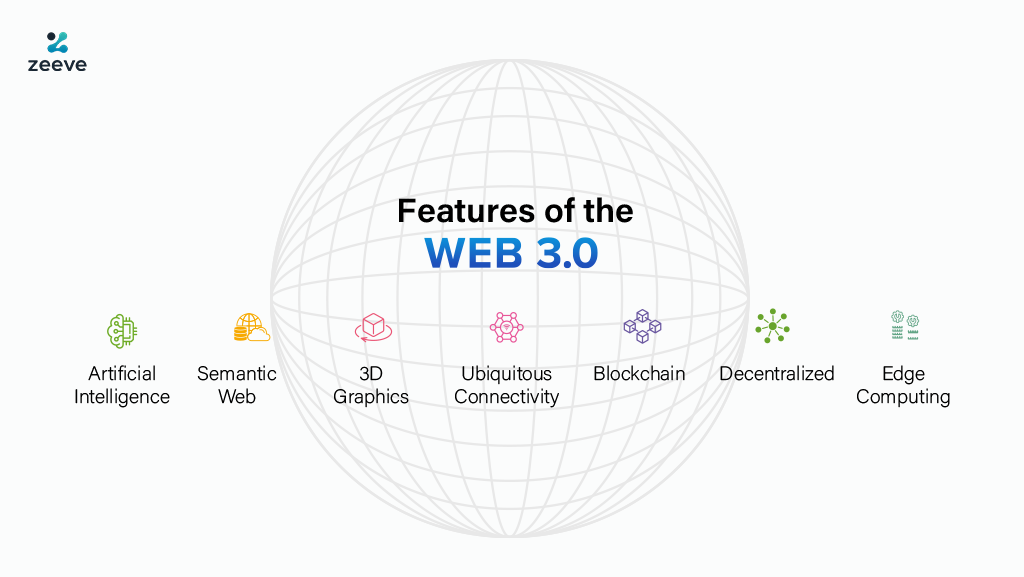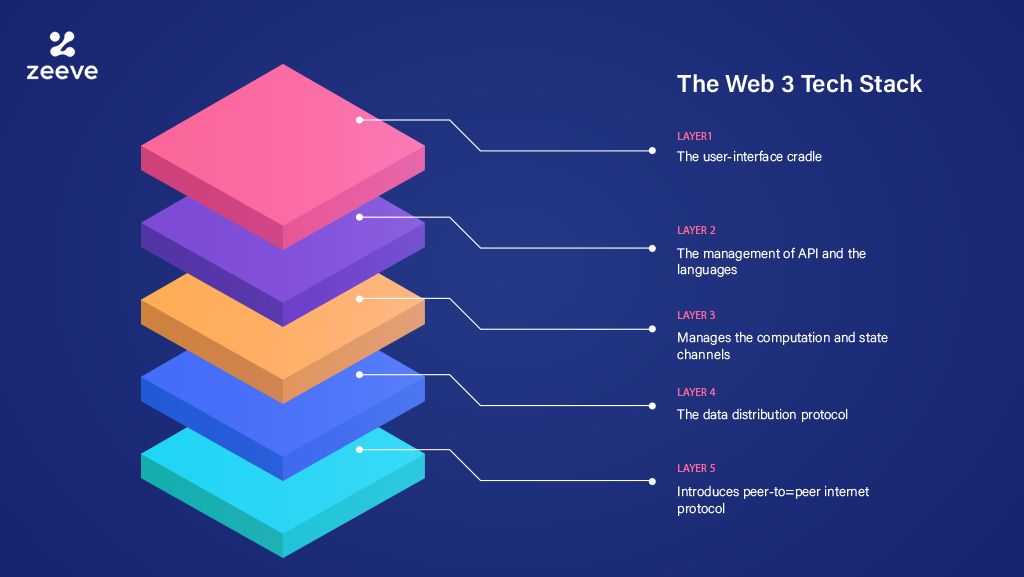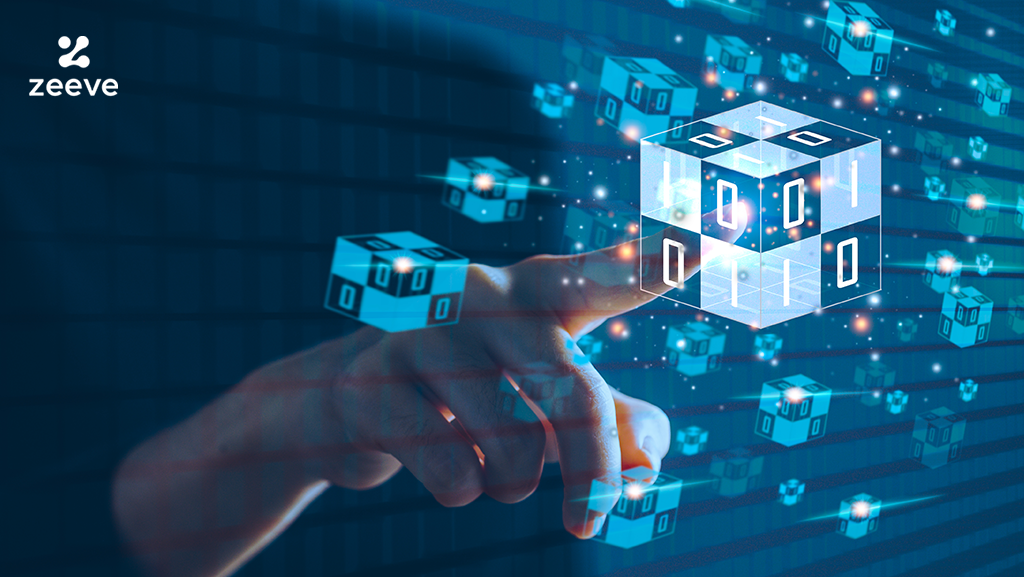Web 3.0 is the next iteration of the World Wide Web, which aims to shift power from large corporations to individual users. Its main focus is on decentralization, transparency, and security. Web 3.0’s goal is not just about interpreting your input but also empowering individuals like you to do what they want and, as a result, expanding the world. From static to interactive web powered by AI with the evolution of Web 3.0, users are more empowered, and enterprises are generating more revenue. As a result, the key components of Web 3 have started to take shape and revolutionize the economy.
With Web 3.0, the individual becomes king in regard to computing power. Its objective is to transform the fundamental power dynamics between users and the web by diffusing it. Web 3.0 aims to revolutionize how users interact with their site by assigning more power to individuals and improving transparency.
As per Grayscale, the combined market capitalization of top Web 3 Metaverse crypto networks is $27.5 billion, and that is only a small part of Web 3.0. So, just imagine how vast the network is.
Web 3.0 is independent of traditional third parties, has permissionless access, and presents user ownership of data. In this blog, we will understand about the components of the tech stack of Web 3.0. The components of Web 3.0 that will very soon become mainstream and merging of businesses with Web 3.0. Keep reading!
Web 1.0: Static, Ready-Only
The digital community identifies this first version of the Internet as the first stage of the World Wide Web’s evolution. It’s characterized as a read-only online experience, where users may access information by reading web pages on devices powered by the browser, HTML technologies, the HTTP standard, and URLs. Networked computers are unknown, and all pages are given hyperlinks and are interconnected. Web 1.0 is also known by the Syntactic Web, and the role of the user is limited.
Web 2: Centralization of technology giants
Known as the second-generation web, Web 2.0 is known as the read-write web or the social web because it allows interactions between users and websites. Driven by mobile, social networks, and cloud technology, users can use Web 2.0 to read and write content on website developments and applications and resell it between websites.
Many large corporations, including the social media site Meta, previously Facebook, YouTube, and Twitter, dominate the market in the digital era. As a result, users’ distributed data processing and revenue are severely tilted with their predominance. The battle between Web 3.0 and Web 2.0 illustrates these problems, which underlie the apparent discrepancies between users’ behavior and the information the data industry collects and distributes.
Challenges of Web 2.0
The present-day Web is static and cannot adjust to the user’s particular requirements. Web 3.0 is anticipated to be more flexible and responsive by implementing artificial intelligence and blockchain technology; it will have substantial structural transformation as a way to ensure greater democratization in all areas of the net. In Web 3.0, data is safeguarded.
Currently, in Web 2.0 peer-to-peer interactions are intervened by third parties. Thus there is heavy control over the data. The user completely loses control over the data as the service provider collects the information to initiate any type of transaction. The current infrastructure of the internet is client-server-based. No doubt, Web 2.0 brought a social revolution but the future lies in – Web 3.0.
In Web 3.0, data is stored securely and distributed across many devices, doing away with the requirement for centralized servers. Such a design also minimizes the threat of massive data leaks since information is now not centrally stored, so it is more resilient to breach.
Web 3.0 Definition and Features
Web 3.0 is highly decentralized, powered by artificial intelligence and machine learning, and uses blockchain technology. As a result, real-world human communication is made possible through the use of decentralized, peer-to-peer technology. Users retain control over their data and content, and they can sell or trade their data and information without losing ownership, risking privacy, or depending on middlemen. With this business model, users can log into a website whenever they want. .
Digital asset digitization is the key innovation of Web 3.0, just as blockchain network tokenization is. Digital asset tokenization converts assets and rights into a digital representation on a blockchain-based network. Ethereum is one type of fungible token, while nonfungible tokens often take the form of collectible digital goods that look and function like real-world goods. NFTS are cryptocurrencies that represent unique assets, including avatars, digital art, or trading cards, that can be owned and traded by users, optionally at their own initiative.
It’s quick to identify the major differences between Web 1.0 and Web 2.0. With the classic version, users passively browse web pages and, usually, do not create their own content. With the second version, users create content and interact with websites (and each other) through social media platforms, forums and more. With the third generation of the internet, the differences are more evident.
Features Of Web3
- Semantic Web: The term describes provides the web technologies to understand the meaning of searches instead of only relying on automatically fed keywords.
- Artificial Intelligence: The semantic search is being combined with natural language processing thus the computers can understand any information on a humane level.
- Blockchain: The technology is an integral part of Web3, which works on encryption and further creates a decentralized user environment.
- 3D Graphics: 3D is one of the ways to make the website interactive. Web3 aims to bring together the real and virtual worlds to make the network immersive.
- Ubiquitous connections: Due to the growth of IoT devices, the internet has become ubiquitous now; you can access the internet from anywhere via any device.
- Edge Computing: Web3 utilizes edge computing to process the data. In edge computing, the data is collected from on-premise locations. This lets businesses to easily bring online data to improve customer experiences.

Components of the Tech Stack of the Web 3.0
Web 3.0 is the read-write-execute form of the internet. It is also known as the Semantic Web. The apps on Web 3.0 don’t run on a single server but are built on blockchain. Cryptoeconomics collectively operate Web 3.0. The personal data will be more secure on the network. Apart from this, personalization will improve more.
All the five layers combine to form Web 3.0 so as to further create a DeFi dashboard or build an NFT marketplace. The following are the layers of Web 3.0.
Layer 0
Layer 0 has peer-to-peer internet overlay protocols and uses a platform-neutral computation description language. Ethereum Virtual Machine (EVM), Web Assembly works on the layer 0 protocol.
In Web3, the consensus algorithm ensures that nodes are in complete agreement. But we know there are several nodes that are unavailable or unreliable. Layer 0 is the fault tolerance layer which improves the efficiency of the network by removing unwanted nodes and saving on data losses. This can be deployed using virtual machines, sidechains, and understanding participation requirements.
The core layer is simply the blockchain layer, the reason for Web3 development and dApps etc. Layer 0 will soon become more cross-interoperable and there will be multiple chains available to carry the load.
Layer 1
Data distribution protocols and low-trust interaction protocols are layer 1 of Web 3.0 as nodes are required to run the blockchain network. Layer 1 examples are Ethereum, Bitcoin, Polkadot, IPFS, and many more.
The Web3 network is decentralized and with added scalability. Layer 1 controls the distributed computing, nodes, tokens, and storage of the Web3 infrastructure. Nodes are the point of interaction for the network.
Any new block added to the network is first sent across all nodes. The blocks are synced once approved. There are Interplanetary File System (IPFS), which is a distributed network of nodes. The IPFS is helpful to share files, applications, and website data.
Layer 2
The Application Programming Interface, or the API, is the layer that the developers interact with. It acts as a bridge between the backend and the front end of the apps. The second layer protocol handles the state channels, heavy computation, and Oracle.
This technology layer controls the computation to run the dApps layer. It is in the form of Data feeds and off-chain computing and pays significant attention to governance, such as by using DAO.
Decentralized Autonomous Organization (DAO) uses a bottom-up approach and is community-led and autonomous, as the name suggests. In a Decentralized Autonomous Organization, the rules are made by core community members by utilizing smart contracts functionality.
Layer 3
Layer 3 is for languages here you need to run the backend to use APIs. The language of Ethereum “Solidity”, Web3.js, and Rust are examples of Layer 3. The layer is crucial to establishing the P2P network. The layer also manages the flow of data on the network.
The APIs allow the developers to work independently on the network. This is the layer where the focus is mainly on addressing, transmitting, and routing the data. The layer also builds an interface for applications thus, the users can later communicate in the network.
You can collaborate with API providers such as Zeeve to connect with the nodes. By deploying the API it becomes easy to access the on-chain data.
Layer 4
The top layer of the Web 3 tech stack is protocol-extensible with user-interface such as Metamask, Parity, and MyCrypto. The layer which has the UI/UX interaction. A regular browser such as Chrome doesn’t provide the infrastructure to operate the Web3 components.
Therefore, the layer makes the dApps available to us through cloud storage. The application hosting is done on a decentralized SaaS network. The users are able to integrate and access the dApps from layer 4.
The user-friendly frontend makes the interaction of the public easy on the decentralized network. The layer is also essential to combine different components such as Data and Analytics, NFT, and DeFi to build different dApp categories.

The components of Web 3.0
The key technology for Web 1.0 was HTML. Similarly, for Web 2.0, it was dynamic HTML and Javascript. Likewise, the Web 3.0 relies heavily on the blockchain and its entities such as smart contracts, crypto and many more.
Blockchain
Blockchain is the core technology of Web 3. As in Web 3.0, the idea is to have serverless data. There is a network of computers that are connected to each other. With the blockchain, there will be peer-to-peer data interaction. The decentralization feature will also go stronger. Blockchain is what favors the decentralization protocol. Conventional data processing is now done on a trustless network on blockchain.
Smart Contracts
When we say web 3 is faster, the reason is automation. What these contracts do is that they automate the agreements. Smart contracts are the digital contracts on the blockchain network that automatically get executed once the terms and conditions are met. While conducting business, business teams collaborate with developers to explain the agreements they want to add to the contracts.
Developers add all the conditions such as payment, the scope of work, shipment, etc. The developers then test the smart contracts on a smart contract writing platform. Lastly, security testing is done.
Then finally the contract is deployed on the blockchain. The update of contractual events is done by “Oracle” – a cryptographically secure streaming data source as the events are executed by both parties. Thus, the contract gets executed itself.
Cryptocurrency
The arrival of Bitcoin is one of the reasons for the popularity of Web 3.0. Cryptocurrency is a digital currency secured by cryptography. The foundation of crypto lies in the blockchain. It is considered a faster, and cheaper way to transfer money. Cryptocurrencies don’t have a single point of failure. Hashing functions, private keys, and encryption are a few of the technologies that make crypto secure.
Non-Fungible Tokens
Non Fungible tokens(NFTs) are also one of the unique components of Web 3.0. It works similarly to cryptocurrencies work i.e. on a blockchain framework. A major difference between NFT and cryptocurrency is while the crypto can be traded or exchanged; an NFT cannot be.
NFTs are mainly known to promote artwork however that’s not always true. An NFT can be artwork, collectibles, essays, games, domain names, and much more. NFTs can be used as collateral to borrow money. Many enterprises are using NFTs to boost consumer engagement and revenue. Rarible, Open Sea are few of the markets to buy and sell the NFT while adhering to the community rules.
Dapps
It is an application built on a decentralized network that combines the smart contract and the frontend user interface. The difference here is that the backend code is running on a decentralized network unlike the centralized network as in Web 2.0.
Dapps are popularly built on the Ethereum platform. The transactions are being done on the crypto. The dapps are known for zero downtime, immutable has the smart contract for a trustless computation. Examples can be Tor, BitTorrent,etc.
DeFi
Decentralized Finance (DeFi) uses the DAO to make the platforms fully decentralized. DeFi provides financial services that are built on the blockchain network. By DeFi the financial services will follow a trustless framework with better transparency.
The major role of DeFi is providing banking services, borrowing platforms, and promoting DEX, tokenization platforms, derivatives, and prediction markets.
Metaverse
The term was first heard in A Sci-fi novel show Snow Crash. It is an immersive way to interact with people online. Many games like Fortnite are a way to connect virtually. Similarly, Roblox offers businesses to enter the Metaverse experience. Solely, Meta has spent $10 billion on the creation of Metaverse, building the future of social connections.
As 3-D graphics is one of the features of Web 3.0, Metaverse can perfectly showcase that. The metaverse is an integrated network that presents a 3-D world. As an immersive personalized experience is a part of Web 3. To access the world one needs a virtual reality (VR) headset. Through this, the users can navigate the metaverse using feedback controllers, eye movements, or voice commands.
Web 3.0 and Business
Most businesses should invest in developing the infrastructure for blockchain protocols, AI-based solutions, and more. As we all know, how tremendously Web 2.0 changed the economic scenario. Brands are leveraging technology more and more to earn revenue. Undoubtedly, Web 3.0 will very soon become mainstream. Thus, Web 3 helps businesses by:
- Brands can initially invest in the Augmented Reality and 3D features of Web 3 as it is one of the excellent ways to engage with consumers.
- IoT devices are also a way to promote the ubiquity feature of Web 3. As the 5G network is reaching the masses the usage of IoT devices will increase.
- With Web 3 being more user-centric and decentralized, the companies can improve the frontend. Therefore, messaging platforms and social media will become better.
Monetary transactions and financial services will be less prone to hackers due to the usage of DeFi. Companies can save themselves and their consumers from fraudulent money practices by managing all transactions on the decentralized network.
Bottomline
The internet algorithms are becoming intelligent and humane. If you are keen to build a Web 3 project, there are plenty of new advancements to learn. Currently, Web 2.0 is very user-friendly and people have understood how to use it. However, Web 3 is becoming easier and more accessible. The components of Web 3.0 will keep increasing and improving as well. A basic understanding is essential to equip yourself with the new version of the Internet.
Collaborate with Zeeve
Need assistance in Web 3.0 and Web3-related projects? Partner with Zeeve. Zeeve is the leading Web 3.0 and Blockchain Infrastructure Management platform trusted by thousands of Blockchain Startups, Enterprises, and Web 3.0 Developers. To learn more about Zeeve, feel free to connect with us on Twitter and Telegram.






















